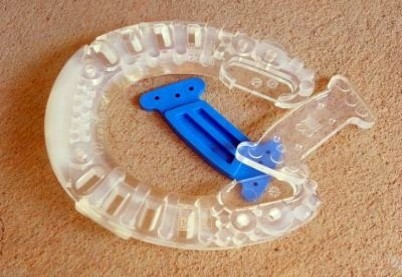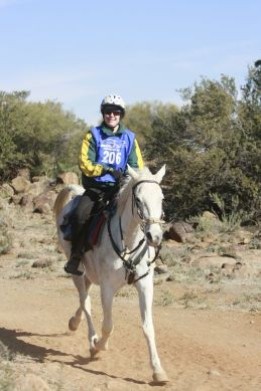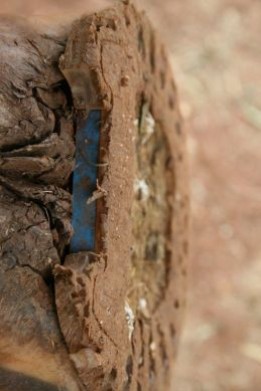Frequently Asked Questions
1. What is the cost of a pair of shoes?
A CERA Shoe consists of a hoof-plate, bridge, mating bridge and six screws. The cost depends upon the design:
i. Pair(2) of Standard Shoes (Equi **) - $28.oo
ii. Pair(2) of Natural Balance Shoes (HIPPO NBS) - front shoe - $34.80
iii. Pair(2) of Standard Shoes with 4 inserts 1/4'' stud spikes to screw in (Equi **) ~ $60.oo
In addition, you may need the CERA nail punch - $45.oo and the CERA clinch adaptor - $15.oo
Bulk prices are available - please enquire. Farrier Starter Kit - $354.20
2. Can you tell me are there any horse disciplines/events that the CERA Endurance Shoe would not be suitable for? Are there any limitations on use?
You asked about on what kind of horses/disciplines the shoe would not work:
1. Big and very heavy horses (that’s why our shoes stop at size 05)
2. Horses with a very irregular shaped hoof (e.g. flat on one side and steep on the other)
3. Horses which walk extremely unbalanced and uneven (like turning the hooves a lot on the ground, not landing flat) BUT we had horses which walked bad on steel and did great on plastic (so sometimes it is worth a try!)
4. Most important limitation in my opinion is the not-use of big studs. We do have a big problem when the rider wants to use big studs (like jumpers and 3-day-eventers) because the flexibility of the material (which is an advantage; in this particular case unfortunately is a disadvantage) allows the big stud used on hard surface (even grass arenas) to cause pressure on the heels! Some horses went lame! We recommend using "other" studs only on soft surfaces and not bigger than 1 cm!
Most of riders are fine with the screw in or knock in spikes produced by CERA Endurance Shoes though. Most endurance riders use the screw in studs.
3. What do I need to shoe my horse? What makes a shoe?
A CERA Endurance Shoe consists:
i. of a hoof plate - either a HIPPOFLEX - Natural Balance Shoe (front only) or an EQUIFLEX shoe (front and hind makes)
ii. a bridge and a mating bridge (not optional!)
iii. 6 screws
To shoe your horse you will need:
i. a nail punch to receed the nails securely down into the hoofplate
ii. a clinch adaptor for pincers - essential to secure the nails correctly
iii. a drill and 3mm drill bit to make nail holes in the hoof plate
iv. a drill to screw bridge and mating bridge to the hoof plate
v. farrier tools to trim hoof and apply shoe(hoof plate)
vi. six E5 nails(large nails) to fix hoof plate to the horses' hoof
4. Is there only one design for the CERA Endurance Shoe?
CERA has designed shoes to fit both the front and hind hooves.
There are three shoe designs to choose from:
i. Standard Shoe(Hoof plate) which comes in five lengths, with three clips designed for front and/or back hooves.
ii. Natural Balance Shoe (NBS) which comes in three sizes - small, medium and large for front hooves only.
iii. Hoof plates with 4 inserts 1/4'' stud spikes to screw in for extra durability. Similar to the standard shoe.

5. How long between shoeing?
A correctly fitted CERA Endurance Shoe horseshoe has a normal shoeing period of 6 weeks. Having said this, common sense and horse welfare must prevail.
When you shoe your horse or trim your horse is up to your discretion.
I know barefoot trimmers who trim every week, and others who trim every 3 months.
With the first shoeing with the CERA Endurance Shoes, I found that my mares hooves expanded and I had to re-shoe after only two weeks. However, the second set of shoes will be on about four and a half weeks, then I will re-shoe her for another ride (and not because the shoes are worn out). I perfer not to go any longer than 4 to 6 weeks between shoeing, and generally average 3 to 4 weeks between shoeing. The shoes maybe re-applied if not worn out.
6. I'm confused about the studs and spikes - please explain?
The screw in stud spikes are generally used by high level riders such as endurance riders, eventers and competitive trail riders.
Belinda Hitzler, a successful German endurance rider only uses the screw in studs - even in training sessions! The screw in stud spikes are useful when the horse needs more grip such as in muddy conditions or needs more durability such as on asphalt and gravel roads.
The screw in spike studs stay on better then the knock in studs. Also, the rider has the chance, when screwing them in for the first time to adjust the height of the stud. And last but not least, the screw in spike studs have a special core insert made of Vidia Steel, which makes them resistant to wear and gives longer durability. Make sure that you pre-drill the hole all the way through the hoof plate before screwing in the stud from hoofside to streetside (so all the material is out and no material can cause pressure on the sole).
The price for screw in studs is $3 each. Special CERA Endurance Shoes are designed to take 2 or 4 screw in studs(1/4 '').
The knock in stud spikes are fine for pleasure riding (anyone who rides maybe once or twice per week in the woods at a relaxing speed). These studs are cheaper as there is the slim chance of loosing them. Make sure that you pre-drill the hole all the way through the hoof plate before knocking in the stud. There is a special tool to assist with knocking in the spike studs called a "striking aid for spikes".
The knock in stud spikes can go in any CERA Endurance Shoe. The price for one knock in stud is $1.60. A hoof plate takes 2 or 4 knock in studs.
In addition, CERA Shoes can came specially prepared to have screw in studs [ various sizes with washes ... that can be screwed in when needed for competition when the surface calls for extra traction.] This is great for eventing and show jumping.
We have 5mm, 8mm and 11mm studs. The rider just has to make sure to use the bigger studs with a washer!!! Otherwise you cannot tighten them correctly.
These shoes come with a metal insert where you can screw in the studs. These shoes allow the smaller screw-in spikes to be left in the shoe all the time. It is recommended to take out the big studs when riding on hard surfaces. So to tighten the big studs you will need to use washers between the stud and the shoes.
There are also smaller tungstant tipped screw in studs that stay in permanently, but these are mainly to prolong wear and used by long distance endurance riders covering distances of 160km and more in a single event.
7. When do you use the Heartbar Bridge?
We use the Heartbar Bridge when extra frog support is needed, e.g. Horses with a very sensitive frog and cannot stand any bruises even from little stones. The rest of the hoof must be filled up with silicon or products from Vettec otherwise little rocks can get stuck between the bridge and the frog.
The Heart bar Bridge is more for therapeutic reasons. Maybe used by competitive rider on rocky terrain.
Currently out of stock.
8. I want to know about gluing the shoes onto the hoof. Some of the CERA websites in different countries say " With additional processes CERA Shoes can also be glued." Are you able to give advice on this please?
CERA Endurance Shoes can be glued very well because most of the glues are made on a Polyurethane base and so is our shoe. So the shoe and the glue combine easily! BUT (unfortunately there is always a BUT) gluing shoes is USUALLY only for therapeutic reasons. A glued shoe will never stay on the hoof as long as a nailed shoe! So if someone wants plastics but the hoof wall is very broken so new nails would cause even more damage on the wall, gluing is great until the hoof recovers and is good enough to nail it on again.
The products from company Vettec are great when in comes to glues and pads.
CERA Endurance Shoes where glued onto a jumping horse's hooves (pretty big and heavy warmblood). The shoes stayed on great for about 3 weeks (including jumping sessions) and then, all 4 shoes fell off within 2 days!!! So with this knowledge, the shoes could be glued on just prior to an endurance ride and probably last the distance. There are no guarantees, but any feedback on your experience in this area would be appreciated.
9. Who can I talk to about sizing and ordering some CERA Shoes for my horse?
Contact: Clare Fleming
Phone: 04 00 89 04 46
Email: flemingoendurance@gmail.com
10. What's in a Farrier Starter Kit?
A Farrier Starter Kit has a minimum of one pair of each shoe [both standard shoe – Equi; and Natural Balance Shoe – Hippo] and 2 pairs of each bridge size from size 1 to size 6 plus screws. It contains everything but the CERA tools that the farrier will need to correctly size and fit the CERA Shoe.

Left: Clare Fleming riding with CERA Endurance Shoes in Fauresmith in the South African National Championships in 2009.
Right: This is a front shoe that has completed an 84km endurance ride at Imbil in Queensland. There has been very little wear to the 14mm shoe.
